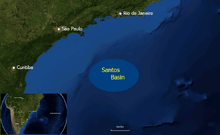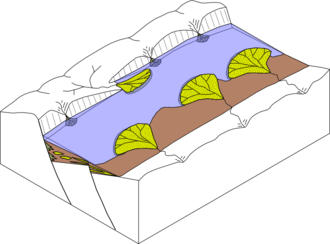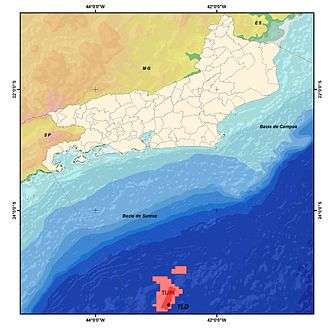Guaratiba Group
The Guaratiba Group (Portuguese: Grupo Guaratiba) is a geological group of the Santos Basin offshore of the Brazilian states of Rio de Janeiro, São Paulo, Paraná and Santa Catarina. The group forms the pre-salt layer in the petroleum-rich basin and hosts the biggest oil fields of Brazil, as Lula, Júpiter and many more. The group contains, depending on the definition, three to four formations and dates to the Early Cretaceous period; Hauterivian to Early Aptian epochs. The total thickness of the group, representing the first phase of sedimentation after the break-up of Gondwana in the Santos Basin, is estimated at 4,200 metres (13,800 ft).
| Guaratiba Group Stratigraphic range: Hauterivian-Early Aptian ~130–120 Ma | |
|---|---|
| Type | Group |
| Sub-units | Piçarras Fm., Itapema Fm., Barra Velha Fm. |
| Underlies | Ariri Formation |
| Overlies | Camboriú Formation |
| Thickness | up to 4,200 m (13,800 ft) |
| Lithology | |
| Primary | Limestone (coquina), marl, shale, siltstone |
| Other | Sandstone, conglomerate |
| Location | |
| Coordinates | 26°6′S 43°43′W |
| Region | Santos Basin, South Atlantic |
| Country | |
| Type section | |
| Named for | Guaratiba |
 Location of the Santos Basin | |
Etymology
The formation is named after Guaratiba, a neighbourhood in the west of Rio de Janeiro.
Description
The Guaratiba Group is 4,200 metres (13,800 ft) thick and subdivided into three formations, four if the underlying basalts of the Camboriú Formation are included,[1] and five if the salt layer of the Ariri Formation is included,[2] from old to young the Piçarras, Itapema, and Barra Velha Formations.
Subdivision


- Piçarras Formation
The Piçarras Formation is 990 metres (3,250 ft) thick and consists of clastic and carbonate rocks. The formation includes reddish polymictic conglomerates, with clasts of basalt and quartz in a clay-sandy matrix. It also includes white, reddish lacustrine coquinas (shelly limestones) and sandstones, siltstones and shales of stevensite composition. Its age, based on the ostracod assemblages, is Hauterivian to Aptian.[1]
The conglomerates and sandstones of the formation are representative of an alluvial environment. The coquinas represent a shallow lacustrine environment. Similar to the Atafona Formation of the Campos Basin, the sandstones, stevensite-bearing siltstones and shales represent an alkaline lacustrine environment affected by volcanic activity. The shales represent deeper lacustrine waters in more distal areas. The alternation of the two facies implies a series of alluvial progradation-retractions into the Early Cretaceous carbonate lakes. The low textural and compositional maturity of conglomerates and sandstones implies the basin was supplied from areas close to the basin margins.[3]
- Itapema Formation
The Itapema Formation is several hundreds of metres thick and consists of calcirudites (limestones) and dark shales. The calcirudite limestones consist of fragmented bivalve shells, frequently dolomitized and silicified. In more distal sections, the formation consists of dark organic matter rich shales. In the well 1-RSJ-625, the formation includes 110 metres (360 ft) of radioactive shales interbedded with carbonates. These facies are thought to represent a lacustrine environment. The organic matter-rich shales are one of the main source rocks of the Santos Basin. This formation is correlative with the Coqueiros Formation in the Campos Basin. The age of the Itapema Formation is Barremian to Aptian.[3]
- Barra Velha Formation
The Barra Velha Formation is approximately 300 to 350 metres (980 to 1,150 ft) thick. In the proximal sections, the formation comprises limestones of stromatolites and laminated microbialites. In the distal sections, it is composed of shales. Interbedded with the laminated microbialites there are limestones with packstone and grainstone textures made up of algal clasts and bioclasts (fragmented ostracods). The carbonates frequently are partly or completely dolomitized. These facies represent a transitional continental and shallow marine environment. The age of this formation has been estimated to be Late Barremian to Aptian. It is correlative with the Macabu Formation in the Campos Basin, as both are typified by laminated microbialites and stromatolites. These limestones are one of the sub-salt reservoirs in the Santos Basin, most notably of the giant Lula and initially reported as supergiant Lapa Fields.[3][4]
Petroleum geology
The formation hosts the important pre-salt reservoir rocks of the Santos Basin.[5][6]
| Field | Year | Operator | Reserves (in place unless otherwise noted) | Notes |
|---|---|---|---|---|
| Sagitário | 2013 | Petrobras | ||
| Libra | 2011 | Petrobras | 8,000–12,000 million bbl (1,300–1,900 million m3) (recoverable) | |
| Búzios | 2010 | Petrobras | 3,058 million bbl (486 million m3) | |
| Iara | 2008 | Petrobras | 3,000–4,000 million bbl (480–640 million m3) | |
| Iracema | 2008 | Petrobras | ||
| Júpiter | 2008 | Petrobras | 1,600 million bbl (250 million m3) 17 trillion cu ft (480 billion m3) | |
| Sapinhoá | 2008 | Petrobras | 1,100–2,000 million bbl (170–320 million m3) | |
| Lapa | 2007 | Petrobras | 459 million bbl (73.0 million m3) | |
| Lula | 2006 | Petrobras | 8,000 million bbl (1,300 million m3) | |
See also
References
- Clemente, 2013, p.20
- Contreras, 2011, p.22
- Clemente, 2013, p.21
- Ribeiro da Silva & Pereira, 2017, p.136
- "Karoon – Santos Basin Fields". karoon.com.br. Archived from the original on 2017-09-07. Retrieved 2017-09-08.
- Vieira, 2007, p.9
- Juarez, 2013, p.44
- Moczydlower, 2014, p.42
- Moczydlower, 2014, p.52
- "Buzios (formerly Franco) Field, Cessão Onerosa Region, Santos Basin". Offshore Technology. Retrieved 2017-09-08.
- "Iara Oil Field, Santos Basin". Offshore Technology. Retrieved 2017-09-08.
- "Latin American Herald Tribune - Brazil Confirms Massive Offshore Oil Field". laht.com. Retrieved 2017-09-08.
- "Sapinhoa Oil Field, Santos Basin". Offshore Technology. Retrieved 2017-09-08.
- Juarez, 2013, p.24
Bibliography
- Clemente, Pilar. 2013. Petroleum geology of the Campos and Santos basins, Lower Cretaceous Brazilian sector of the South Atlantic margin, 1–33. Danmarks Tekniske Universitet. Accessed 2017-09-04.
- Contreras, Jorham. 2011. Seismo-stratigraphy and numerical basin modeling of the southern Brazilian continental margin (Campos, Santos, and Pelotas basins) (PhD thesis), 1–171. Ruprecht-Karls-Universität Heidelberg. Accessed 2017-09-04.
- Juarez Feijó, Fávio. 2013. Santos Basin: 40 Years from Shallow to Deep to Ultra-Deep Water. Search and Discovery 10553. 1–49. Accessed 2017-09-04.
- Kiang Chang, Hung; Mario Luis Assine; Fernando Santos Corrêa; Julio Setsuo Tinen; Alexandre Campane Vidal, and Luzia Koike. 2008. Sistemas petrolíferos e modelos de acumulação de hidrocarbonetos na Bacia de Santos. Revista Brasileira de Geociências 38. 29–46. Accessed 2017-09-04.
- Moczydlower, Bruno. 2014. Brazilian Pre-Salt & Libra: Overview, Initial Results & Remaining Challenges, 1–80. KIVI Engineering Society. Accessed 2017-09-04.
- Ribeiro da Silva, Suzana Faria Chula, and Egberto Pereira. 2017. Tectono-stratigraphic evolution of Lapa Field pre-salt section, Santos Basin (SE Brazilian continental margin). Journal of Sedimentary Environments 2. 133–148. Accessed 2017-09-04.
- Vieira, Juliana. 2007. Brazil Round 9 - Santos Basin, 1–73. ANP. Accessed 2017-09-04.